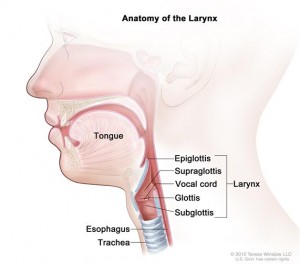
Exactly What is a Larynx and Why Do I Need One?
-
The larynx is a very busy organ. In many ways, it is a crucial gateway as it directs air into the lungs to breathe. It also directs food into esophagus on its way to the stomach.
This simple task is important and disruption to this function can be life threatening. While allowing air into the stomach is not significant, if food particles get into the windpipe (trachea), also called aspiration, this can be life threatening. Repeated aspiration can result in pneumonia, illness and sometimes, death.
The larynx is also responsible for creating sound for the voice. The larynx houses the vocal cords that open to allow breathing; close to protect the windpipe when swallowing; and vibrate to give voice. The noise made by the larynx is changed by the tongue, lips and gums to generate speech.

Because the larynx is such a vital organ for breathing, digesting and talking, laryngeal cancer can present in myriad of ways and affect these functions. The location and size of the cancer determine the symptoms with which the patients present.
Cancers of the larynx are generally divided into three general areas:
- Below the vocal cords (subglottis)
- On level with the vocal cords (glottis)
- Above the vocal cords (supraglottis)
Cancers confined to just one of these three areas are managed in very different ways. When cancers span multiple areas, treatment can become more challenging and complicated.
For example, cancers of the vocal cord (glottis), tend to cause hoarseness early. The voice is very sensitive so that small changes to the vocal cords can cause obvious symptoms. Tumors can be tiny – fractions of an inch – and cause significant symptoms. In contrast, tumors above the vocal cords (supraglottis), or behind them (hypopharynx), can go undetected until the tumors become much larger. We also know that cancers of the glottis spread to lymph nodes uncommonly, while tumors of the subglottis and supraglottis often spread to the lymph nodes.
Determining the best treatment for patients with laryngeal cancer is very dependent on the type, size, location and lymph node involvement of the disease. As surgeons, we generally divide cancers into early (stage I or stage II) and late (stage III, stage IV). Broadly speaking, early cancers can usually treated using surgery or radiation alone. Late or advanced stage cancers are treated with a combination of surgery, radiation, and chemotherapy.
Treatment of any cancer, especially advanced stage cancers, is most effective when managed by a team of doctors who are familiar with the disease and who routinely collaborate. As a head and neck cancer surgeon at Fox Chase Cancer Center (now part of Temple University Health System), I routinely work closely with my colleagues in radiation oncology and medical oncology to develop the best treatment plans for our patients.
